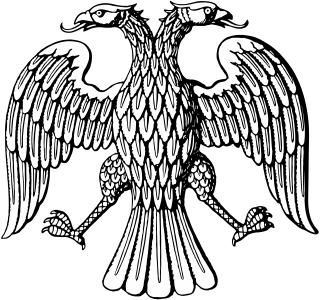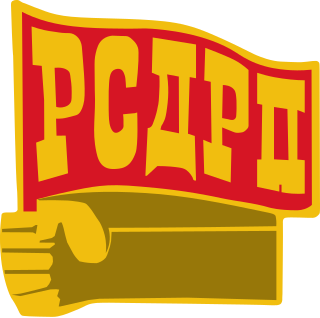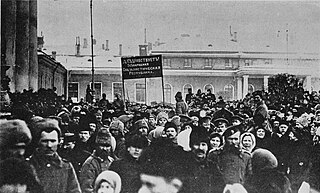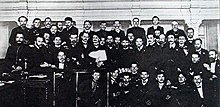
The Bolsheviks, led by Vladimir Lenin, were a far-left faction of the Marxist Russian Social Democratic Labour Party (RSDLP) which split with the Mensheviks at the Second Party Congress in 1903. The Bolshevik party seized power in Russia in the October Revolution of 1917, and was later renamed the Communist Party of the Soviet Union. Their ideology and practices, based on Leninist and later Marxist–Leninist principles, are known as Bolshevism.

Lev Davidovich Bronstein, better known as Leon Trotsky, was a Russian revolutionary, Soviet politician, journalist, and political theorist. He was a central figure in the 1905 Revolution, October Revolution, Russian Civil War, and the establishment of the Soviet Union. Alongside Vladimir Lenin, Trotsky was widely considered the most prominent Soviet figure and was de facto second-in-command during the early years of the Russian Soviet Republic. Ideologically a Marxist and a Leninist, his thought and writings inspired a school of Marxism known as Trotskyism.

The October Revolution, also known as the Great October Socialist Revolution, October coup, or Bolshevik coup was a revolution in Russia led by the Bolshevik Party of Vladimir Lenin that was a key moment in the larger Russian Revolution of 1917–1923. It was the second revolutionary change of government in Russia in 1917. It took place through an armed insurrection in Petrograd on 7 November 1917 [O.S. 25 October]. It was the precipitating event of the Russian Civil War.

The Russian Revolution was a period of political and social change in the Russian Empire, starting in 1917. This period saw Russia abolish its monarchy and adopt a socialist form of government following two successive revolutions and a bloody civil war. The Russian Revolution can also be seen as the precursor for the other European revolutions that occurred during or in the aftermath of World War I, such as the German Revolution of 1918–1919.

The Russian Revolution of 1905, also known as the First Russian Revolution, began on 22 January 1905. A wave of mass political and social unrest then began to spread across the vast areas of the Russian Empire. The unrest was directed primarily against the Tsar, the nobility, and the ruling class. It included worker strikes, peasant unrest, and military mutinies. In response to the public pressure, Tsar Nicholas II was forced to go back on his earlier authoritarian stance and enact some reform. This took the form of establishing the State Duma, the multi-party system, and the Russian Constitution of 1906. Despite popular participation in the Duma, the parliament was unable to issue laws of its own, and frequently came into conflict with Nicholas. The Duma's power was limited and Nicholas continued to hold the ruling authority. Furthermore, he could dissolve the Duma, which he did three times in order to get rid of the opposition.
The history of the Communist Party of the Soviet Union was generally perceived as covering that of the Bolshevik faction of the Russian Social Democratic Labour Party from which it evolved. In 1912, the party formally split, and the predecessor to the Communist Party of the Soviet Union became a distinct entity. Its history since then can roughly be divided into the following periods:
The Executive Committee of the Petrograd Soviet, commonly known as the Petrograd Soviet Ispolkom was a self-appointed executive committee of the Petrograd Soviet. As an antagonist of the Russian Provisional Government, after the 1917 February Revolution in Russia, the Ispolkom became a second center of power. It was dissolved during the Bolshevik October Revolution later that year.

Viktor Pavlovich Nogin was a Russian Bolshevik revolutionary, Soviet politician and statesman in Moscow, holding many high positions in the party and in government, including Chairman of the Moscow Military Revolutionary Committee and Chairman of the Presidium of the Executive Committee of Moscow Council of Workers' Deputies. He was a member of first Council of People's Commissars, i.e., the first Government of Soviet Russia, and People's Commissar for Commerce and Industry.

The All-Russian Congress of Soviets evolved from 1917 to become the supreme governing body of the Russian Soviet Federative Socialist Republic from 1918 until 1936, effectively. The 1918 Constitution of the Russian SFSR mandated that Congress shall convene at least twice a year, with the duties of defining the principles of the Soviet Constitution and ratifying peace treaties. The October Revolution ousted the provisional government of 1917, making the Congress of Soviets the sole, and supreme governing body. This Congress was not the same as the Congress of Soviets of the Soviet Union which governed the whole Soviet Union after its creation in 1922.

The All Russian Constituent Assembly was a constituent assembly convened in Russia after the February Revolution of 1917. It met for 13 hours, from 4 p.m. to 5 a.m., 18–19 January [O.S. 5–6 January] 1918, whereupon it was dissolved by the Bolshevik-led All-Russian Central Executive Committee, proclaiming the Third All-Russian Congress of Soviets the new governing body of Russia.

Lev Borisovich Kamenev was a Russian revolutionary and Soviet politician. He was born in Moscow to parents who had both been involved in revolutionary politics in the 1870s. He joined the Russian Social Democratic Labour Party (RSDLP) in 1901 and was active in Moscow and Saint Petersburg. Kamenev participated in the failed Russian Revolution of 1905. Relocating abroad in 1908, he became an early member of the Bolsheviks and a close associate of the exiled Vladimir Lenin. In 1914, he was arrested upon returning to Saint Petersburg and exiled to Siberia. Kamenev was able to return after the February Revolution of 1917, which overthrew the Tsarist monarchy. In 1917, he served briefly as the equivalent of the first head of state of the All-Russian Congress of Soviets. He disagreed with Lenin's strategy of armed uprising during the October Revolution but nevertheless remained in a position of power after the fall of the Provisional Government. In 1919, Kamenev was elected a full member of the first Politburo.

Julius Martov or L. Martov was a Russian politician, revolutionary and the leader of the Mensheviks, a faction of the Russian Social Democratic Labour Party (RSDLP). A close associate of Vladimir Lenin, Martov broke with him following the RSDLP ideological split, after which Lenin led the opposing faction, the Bolsheviks.

The Mensheviks were a faction of the Marxist Russian Social Democratic Labour Party (RSDLP) which split with Vladimir Lenin's Bolshevik faction at the Second Party Congress in 1903. The Mensheviks were led by Julius Martov and Pavel Axelrod.

The Russian Social Democratic Labour Party, also known as the Russian Social Democratic Workers' Party or the Russian Social Democratic Party, was a socialist political party founded in 1898 in Minsk.
The Petrograd Soviet of Workers' and Soldiers' Deputies was a city council of Petrograd, the capital of Russia at the time. For brevity, it is usually called the Petrograd Soviet.
Soviet democracy, or council democracy, is a type of democracy in Marxism, in which the rule of the population is exercised by directly elected soviets, or workers' councils. The councils are directly responsible to their electors and bound by their instructions using a delegate model of representation. Such an imperative mandate is in contrast to a trustee model, in which the elected delegates are only responsible to their conscience. Delegates may accordingly be dismissed from their post at any time or be voted out (recall).

The February Revolution, known in Soviet historiography as the February Bourgeois Democratic Revolution and sometimes as the March Revolution, was the first of two revolutions which took place in Russia in 1917.
The All-Russian Executive Committee of the Union of Railwaymen, commonly known in English by its Cyrillic acronym, Vikzhel, was the governing body of an industrial union established in revolutionary Russia during the summer of 1917. Inclined towards syndicalism and standing as one of the most radical Russian unions of the period, Vikzhel played a decisive role in stymying the attempted Kornilov coup in August 1917.

The Second All-Russian Congress of Soviets of Workers' and Soldiers' Deputies was held on November 7–9, 1917, in Smolny, Petrograd. It was convened under the pressure of the Bolsheviks on the All-Russian Central Executive Committee of the First Congress of Soviets of Workers' and Soldiers' Deputies.
The Bolshevization of the soviets was the process of winning a majority in the soviets by the Russian Social Democratic Labor Party (Bolsheviks) in the second half of 1917. The process was particularly active after the Kornilov Rebellion during September – October 1917 and was accompanied by the ousting from these bodies of power previously moderate socialists, primarily the Socialist Revolutionaries and Mensheviks, who dominated them.















